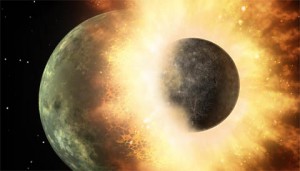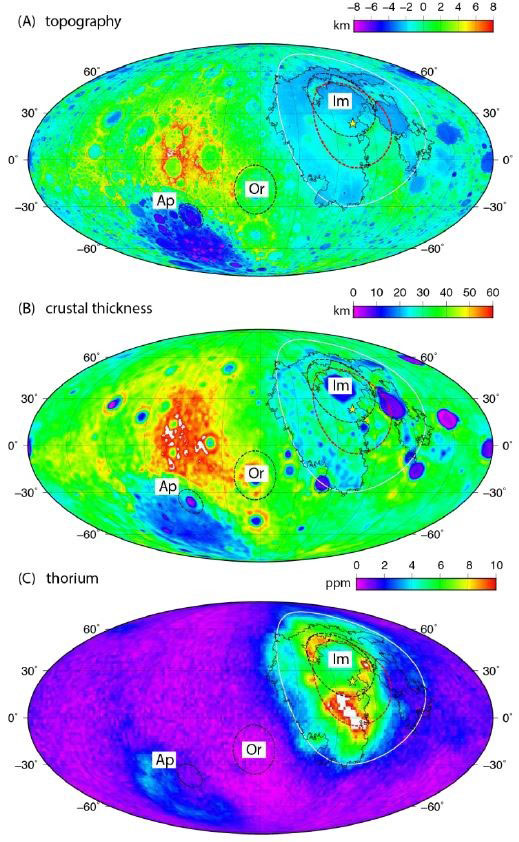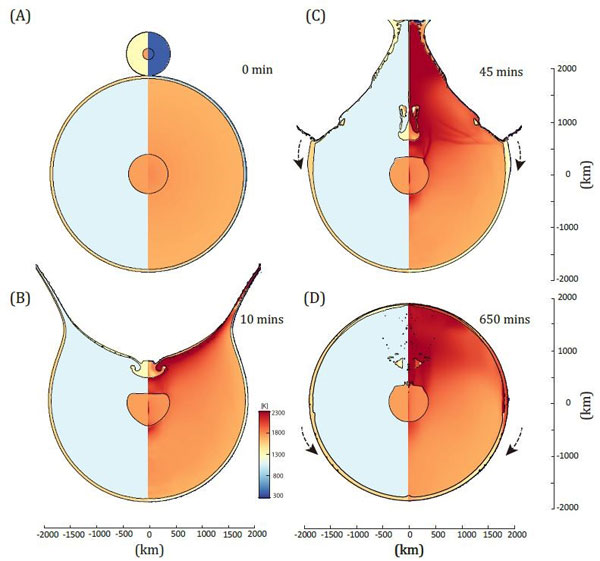New research shows that a planetoid impact could have made our Moon asymmetric.

NASA / JPL-Caltech
Scientists have been scratching their heads about the striking differences between our Moon’s near and far sides for 60 years, since the Soviet satellite Luna 3 orbited the Moon in 1959. When it sent back the first pictures of the Moon’s long-hidden farside, scientists saw it looked nothing like the “Man in the Moon” we’re used to seeing in the sky. Now, a study purports to explain the dichotomy.
Because the Moon orbits Earth so closely, it’s tidally locked, keeping one hemisphere constantly turned toward us and the other turned away. The nearside shows two distinct types of terrain: the lighter-toned highlands and the dark maria (Latin for “seas”). The highlands formed when the Moon cooled down shortly after its formation 4½ billionyears ago; the maria formed much later, about 3.1 to 3.9 billion years ago, when volcanic eruptions filled preexisting impact basins.

JGR: Planets / Zhu et al. 2019 / AGU
In contrast, the heavily cratered lunar farside has almost no maria. While impact basins scar both sides of the Moon equally, lava filled only those on the nearside. NASA’s Gravity Recovery and Interior Laboratory (GRAIL) orbiter has found that an extra layer of material lies on top of the primordial crust.
Scientists have proposed many theories over the years to explain these differences. Some have pointed to the influence of the Earth’s gravity, which might have thinned the crust and increased volcanic activity on the nearside. Others have suggested some sort of cataclysm made the sides so different, such a collision with a sub-Moon or an incoming planetoid.
Meng-Hua Zhu (Macau University of Science and Technology) and colleagues reported May 20th in the Journal of Geophysical Research: Planets that the latter is a real possibility. The team ran a series of computer simulations to show that, under certain conditions, an impact with a dwarf planet slightly smaller than Ceres could produce a two-faced Moon like the one we have today.
For this scenario to work, the impact would have happened after the Moon had formed a solid crust but before that crust became too stiff; otherwise, the surface would have preserved scars from such a massive hit.
In the simulations, the team found that a body 780 kilometers (480 miles) in diameter — a bit smaller than Ceres — would need to hit the Moon’s nearside at 22,500 kilometers per hour (14,000 mph) to reproduce the asymmetry in the crust. Such an impact would have been relatively slow, a quarter of the speed with which meteorites typically hit Earth.
The simulations showed that the impact would have ejected vast amounts of material, which would have landed mostly on the Moon’s farside, burying its original crust in 5–10 kilometers of debris, equivalent to the extra layer detected in GRAIL observations.

JGR: Planets / Zhu et al. 2019 / AGU
However, giant-impact models such as this one not only have to get the mechanics right, they also need to match everything else we know about the Moon.
“It’s very difficult to get a model that claims that it can match all the constraints,” says William Bottke (Southwest Research Institute), who wasn’t involved in the study. There are a lot of constraints: We know the thickness of the Moon’s crust, thanks to GRAIL observations, but we also know chemical and isotopic composition of the surface rocks. The Moon and Earth have strikingly similar isotopic compositions, suggesting that their building blocks already had the same isotopic composition or that some unknown mechanism stirred everything together right after the Moon formed. If a giant impact, such as the one proposed by Zhu and colleagues, added a substantial amount of material to the Moon after it formed, it’s very unlikely that the Moon would still have an isotopic composition identical to Earth’s. “If they can indeed fulfill all these constraints, then I think it’s looking pretty interesting,” Botkke says.
David Stevenson (Caltech), who was also not involved in the study, calls the scenario “unlikely,” — not only because of the isotopic similarity between the Moon and Earth, but also because of the “just-right” timing of the impact. He also finds it too convenient that the impact would produce two distinct hemispheres.
Ultimately, samples from the far side of the Moon could change our understanding of the differences between the Moon’s nearside and farside. At this very moment, the Chinese spacecraft Chang'e 4 is collecting data from the lunar farside. After landing on the Moon on January 3rd, it deployed a small rover called Yutu-2, which has detected signs of excavated mantle material on the farside’s surface. Chang’e 4 isn’t a sample return mission, but the upcoming Chang’e 5 will be, and it’s expected to launch later in 2019.
 1
1









Comments
Peter Cadogan
June 2, 2019 at 9:12 am
As the first person to propose this idea back in a 1974 Nature paper entitled "Oldest and largest lunar basin", I eagerly await further developments!
You must be logged in to post a comment.
You must be logged in to post a comment.